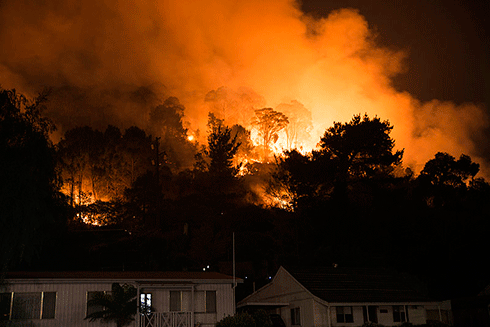
|
Published: 28 October 2013
Fire and climate change: fire risk needs to be managed
Recent fires in New South Wales highlight our current vulnerability, remind us about potential future risks and prompt us to think more strategically about risk management. But what do we mean by fire risk and how can we better deal with it in the future?

|
|
Is climate change to blame for the NSW fires? Credit:
Lithgowlights/Wikipedia
|
Bushfires are influenced by many factors including: warmer and drier conditions in preceding months, days with extreme heat, strong winds and low humidity, urban development patterns, fuel loads and management.
We’ve just experienced Australia’s warmest 12-month period on record, NSW had its warmest January-September on record, and eastern NSW has been very dry.
Together with accumulated fuel loads over the past few years, this provides conditions that increase fire risk. Other parts of Australia need to prepare for an active fire season.
While it’s almost impossible to attribute an individual extreme weather event to climate change, the risk of fire has increased in south-east Australia due to a warming and drying trend that is partly due to increases in greenhouse gases.
What is fire risk?
Fire is a natural part of the Australian landscape. Fire weather risk can be quantified using the Forest Fire Danger Index (FFDI).
Annual cumulative FFDI, which integrates daily fire weather across the year, increased significantly at 16 of 38 Australian sites from 1973-2010. The number of significant increases is greatest in the southeast, while the largest trends occurred inland rather than near the coast. The largest increases in seasonal FFDI occurred during spring and autumn, while summer had the fewest significant trends.
This indicates a lengthened fire season.
Fire risk is different to fire weather risk, as fire risk is affected by other factors, such as vegetation and human behaviour, in addition to the weather.
What can we expect in the future?
Climate change over the coming decades is likely to significantly alter fire patterns, their impact and their management in Australia.
An increase in fire-weather risk is likely with warmer and drier conditions in southern and eastern Australia.
The rate of increase depends on whether global greenhouse gases follow a low or high emission scenario. Carbon dioxide emissions have been tracking the high scenario over the past decade.
The number of ‘extreme’ fire danger days in south-east Australia generally increases 5-25 per cent by 2020 for the low scenarios and 15-65 per cent for the high scenarios. By 2050, the increases are generally 10-50 per cent for the low scenarios and 100-300 per cent for the high scenarios. This means more total fire ban days.
Fire danger periods are likely to be more prolonged, so the fire season will lengthen.
What should we do now?
Without adaptation, there will be increased losses associated with the projected increase in fire weather events.
Adaptation in the short-term can lead to greater preparedness, including many well established actions such as fire action plans, vegetation management and evacuations; while adaptation in the long-term can reduce the fire risk experienced by society, through actions such as appropriate building standards and planning regulations in fire-prone areas.
Kevin Hennessy leads the Impacts, Adaptation and Vulnerability team within the Climate Variability and Change Program at CSIRO Marine and Atmospheric Research. His expertise lies in analysis of observed climatic trends and climate model simulations. He was the Coordinating Lead Author of the Australia and NZ chapter of the 2007 IPCC report on impacts, adaptation and vulnerability. This article was originally published at The Conversation.



